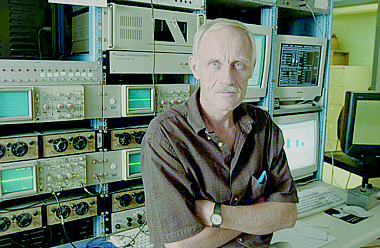The figure is famous: a deceptively simple line
drawing that at first glance resembles a vase and, at the
next, a pair of human faces in profile. When you look at
this figure, your brain must rapidly decide what the
various lines denote. Are they the outlines of the vase, or
the borders of two faces? How does your brain decide?
It does so in a fraction of a second via special nerve
circuits in the brain's visual center that automatically
organize information into a "whole" even as an individual's
gaze and attention are focused on only one part, according
to Johns Hopkins researchers writing in a recent issue of
the journal Neuron.
"Our paper answers the century-old question of the
basis of subconscious processes in visual perception,
specifically, the phenomenon of figure-ground
organization," said Rudiger von der Heydt, a professor in
the Zanvyl Krieger
Mind/Brain Institute. "Early in the 20th century, the
Gestalt psychologists postulated the existence of
mechanisms that process visual information automatically
and independently of what we know, think or expect. Since
then," he said, "there has always been the question as to
whether these mechanisms actually exist. They do. Our work
suggests that the system continuously organizes the whole
scene, even though we usually are attending only to a small
part of it."
The report, based on recordings of nerve cells in the
visual cortex of macaque monkeys, suggests that this
automatic processing of images is repeated each time an
individual looks at something new, usually three to four
times per second. What's more, the brain provides what von
der Heydt calls "a sophisticated program" to select and
process the information that is relevant at any given
moment.

'Our paper answers the century-old
question of the basis of subconscious processes in visual
perception,' Rudiger von der Heydt said.
PHOTO BY HIPS/WILL KIRK
|
"The result of this organization is an internal data
structure, quite similar to a database, that allows the
attention mechanism to work efficiently," von der Heydt
said. "An image can be compared with a bag of thousands of
little Lego blocks in chaotic order. To pay attention to an
object in space, the visual system first has to arrange
this bag of blocks into useful 'chunks' and provide threads
by which one or the other chunk can be pulled out for
further processing."
He noted that the research provides the theoretical
foundation that might one day lead to better diagnosis and
treatment of human brain disorders.
"The last decades have seen rapid progress in the
neurosciences at a very broad front, particularly at the
molecular and cellular levels, and this progress makes it
increasingly clear that we still lack sufficient
understanding of brain function at the 'system level,' " he
said. "We need to understand the basis of mental processes.
Single cell recording in animals is only one approach to
this formidable task. It is complemented by new brain
imaging techniques, traditional psychophysics, psychology
and computational and theoretical neuroscience.
Understanding the function of the visual cortex will help
to interpret neurological symptoms in diseases that produce
disorders of vision," he said.
This work was funded by grants from the National
Institutes of Health.
The paper appeared in the July 7 issue of
Neuron.